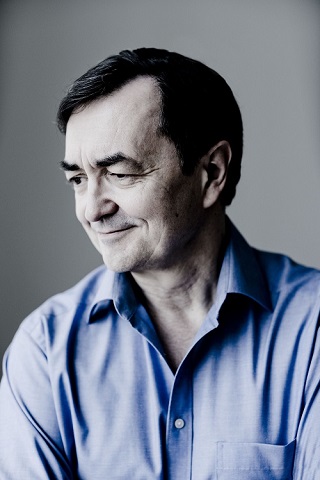 United Kingdom Ligeti in Wonderland: Pierre-Laurent Aimard (piano) plus post-performance discussion. Queen Elizabeth Hall, London, 12.5.2018. (CC)
United Kingdom Ligeti in Wonderland: Pierre-Laurent Aimard (piano) plus post-performance discussion. Queen Elizabeth Hall, London, 12.5.2018. (CC)

Ligeti – Études (Books I-III)
Part of a three-day festival dedicated to Ligeti, this was core Aimard territory. All three books of the Ligeti Études in one concert were to be followed by a discussion with Gillian Moore, the Southbank’s Director of Music.
Aimard is inextricably linked with these pieces. Firstly, from his time with the Ensemble Intercontemporain, of which Aimard was a founding member; in 1987 Aimard gave the French premiere of the first four Études. The rest, as they say, is history: Nos. 10 (Der Zauberlehrling) and 12 (Entrelacs) are both dedicated to Aimard. We heard all three books, in the order 1; 3; 2. In the post-concert discussion, Aimard explained the reasoning: there are only four Études in Book Three, which is the shortest, so Book Two makes a more satisfying ending. The fourth Étude of Book Three, written in 2001, was the last piece Ligeti wrote.
Aimard performed on a Yamaha, which he explained in the post-concert discussion was the best choice of piano for this space and this repertoire. Certainly, the brightness of sound and the transparency were ideal. Ligeti’s studies are unique in their virtuosity, but also in the combination of music and techniques (fractal patterning, African rhythms, the influence of Conlon Nancarrow to name but a few). None of which fazes Aimard in the slightest. He feeds off challenges such as these. During the performance, there were several page-turning hiccups, although Aimard explained afterwards that one was his fault (he had prepared the pages in the wrong order, with two reversed).
The First Book was published in 1985. The brightness of the Yamaha was the first thing to strike the listener in the first Étude (Désordre), a typical Ligeti moto perpetuo; it also sounded more mechanistic on this particular piano. Lines were preternaturally clear. In response, Ligeti offers a post-Debussian meditation on the interval of a perfect fifth. The fifths falling like droplets; Aimard offered a pellucid account. The jerky, nervous third Étude gives way the fanfares of the fourth (those fanfares somewhat muted in this instance, more so than in Aimard’s Sony recording) and the harmonic kaleidoscope of the fifth (Arc-en-ciel/’Rainbow’). The first page-turning incident occurred in the sixth, a shame as it rather detracted from the ongoing concentration for both audience and pianist. Titled ‘Automne à Varsovie’, it is offers a ghost of Chopin with its tender, pathetic descents.
Book Three contains four Études (Nos. 15-18). The chorale-canon of No. 15 (‘White on White’) was perfectly weighted; so fragile, so beautiful. Again, it was the transparency of Aimard’s playing that was so revealing, particularly in the lower registers. The hints of tonality in ‘A bout de soufflé’ (No. 17) were remarkable, while Aimard’s finger strength in the final ‘Canon’ was masterly.
The eight Études of Book Two continued the exhibition of excellence. The shimmering Balinese sounds of ‘Galamb borong’ (No. 7 – the words are actually Hungarian but Ligeti was playing on the fact they sound Balinese) gave way to the buzzing scherzo of ‘Die Zauberlehrling’ (No. 10, based on The Sorcerer’s Apprentice) and the post-Lisztian gestures of ‘L’escalier du Diable’.
The post-concert talk with Gillian Moore came after a 20-minute interval. It was fascinating, Aimard expounding on what he saw as the ‘ambiguity of objects presented’ in the music of Ligeti, on how Ligeti himself worked with the piano, to Ligeti’s love of ‘effort’ in performance. Interesting, too, that Aimard referred to Ligeti’s writing in ‘L’escalier du Diable’ as ‘efficient’, a nod to Ligeti’s notational methods and how he works with the keyboard.
A rather nice gesture was Aimard’s nod to the work of musicologists and their source studies, an area of ‘background’ work that simply goes unnoticed in the general run of things.
The evening presented some of the finest piano playing one could hope to hear. The fact that, for the performance, the hall was packed, gave cause for celebration (there was considerable space after the break).
Colin Clarke
Great concert all round, and informative second half. Page turner should be applauded though, neither incident was their fault on close inspection: I was sitting near enough to see the mess that was those scores, a combination of Ligeti’s spidery handwriting and thirty years of performer’s scrawl. It’s an impressive feat to be able to follow that at all.